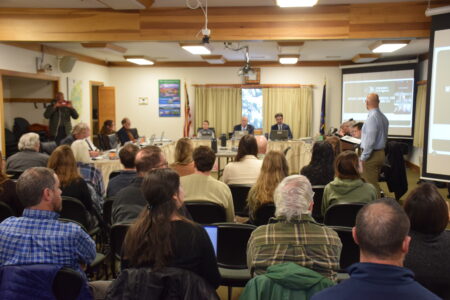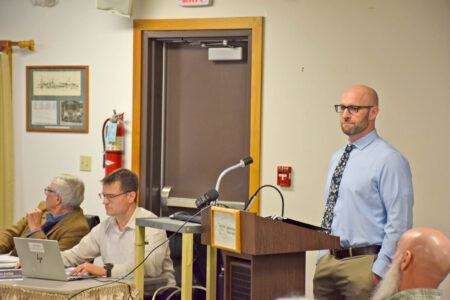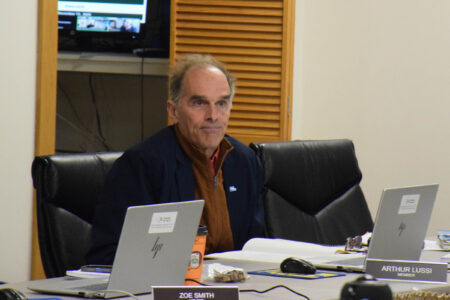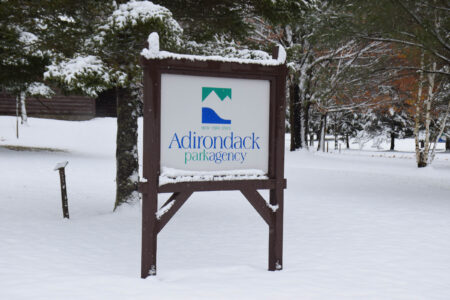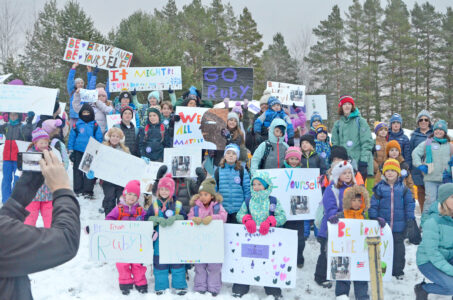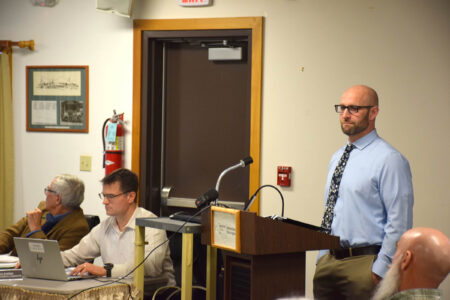APA sends Lewis howitzer range to adjudicatory hearing
- The audience listens as Adirondack Park Agency Deputy Director for Regulatory Programs John Burth presents at the agency’s headquarters in Ray Brook on Thursday on why APA staff recommended the board vote to send the proposed howitzer testing range in the town of Lewis to an adjudicatory hearing. The board voted to do so on Friday. (Enterprise photo — Chris Gaige)
- Adirondack Park Agency Deputy Director for Regulatory Programs John Burth presents at the agency’s headquarters in Ray Brook on Thursday on why APA staff recommended the board vote to send the proposed howitzer testing range in the town of Lewis to an adjudicatory hearing. (Enterprise photo — Chris Gaige)
- Adirondack Park Agency top officials listen to a staff presentation on the proposed Howitzer testing range in the town of Lewis at an agency meeting on Thursday in Ray Brook. From left are Executive Director Barbara Rice, Board Chair Mark Hall and General Counsel Damion K. L. Stodola. On Friday, the APA board voted to send the proposal to an adjudicatory hearing. (Enterprise photo — Chris Gaige)
- Adirondack Park Agency Board Member Art Lussi, of Essex County, looks on at the agency’s meeting at its Ray Brook headquarters on Thursday. Lussi thanked the public for submitting insightful comments on the proposed Howitzer testing range in the town of Lewis. On Friday, the APA board voted to send the proposal to an adjudicatory hearing. (Enterprise photo — Chris Gaige)
- The Adirondack Park Agency sign is seen in front of its Ray Brook headquarters on Thursday. On Friday, the APA board voted to send the proposal to an adjudicatory hearing. (Enterprise photo — Chris Gaige)
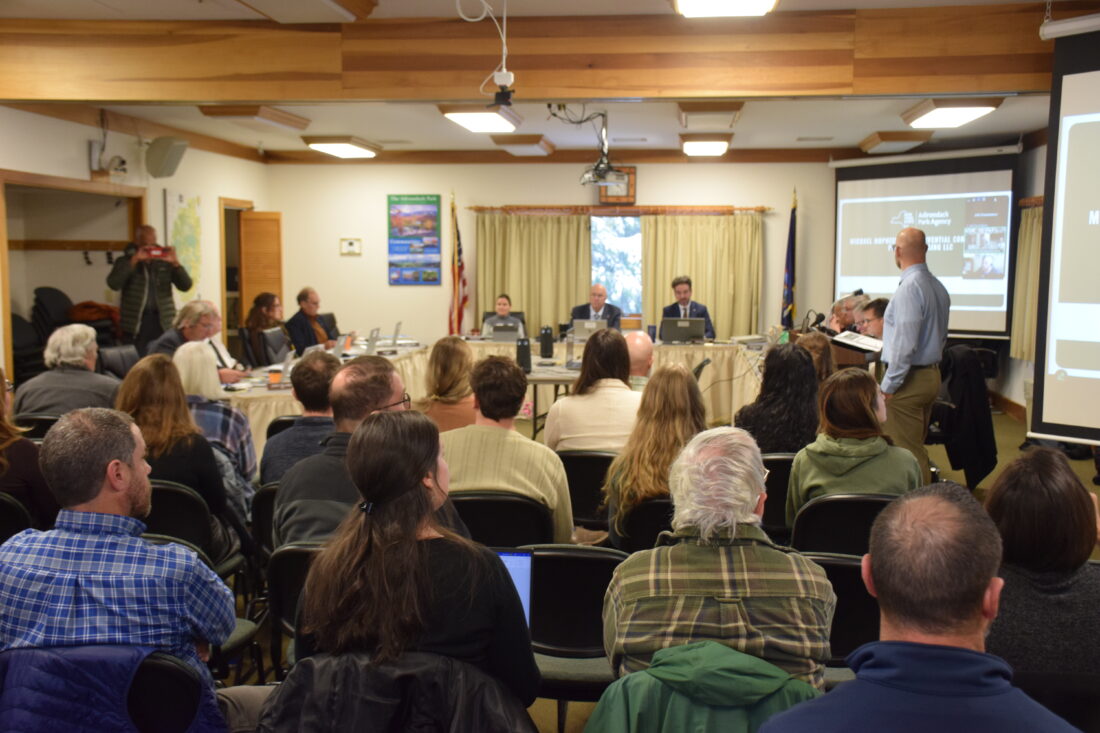
The audience listens as Adirondack Park Agency Deputy Director for Regulatory Programs John Burth presents at the agency’s headquarters in Ray Brook on Thursday on why APA staff recommended the board vote to send the proposed howitzer testing range in the town of Lewis to an adjudicatory hearing. The board voted to do so on Friday. (Enterprise photo — Chris Gaige)
RAY BROOK — The Adirondack Park Agency Board voted unanimously on Friday morning to send a proposed howitzer testing range in the town of Lewis to an adjudicatory hearing.
The move by the full 11-member board follows the recommendation by APA staff. The APA board’s Regulatory Programs committee — consisting of four of the 11 board members — had voted unanimously on Thursday to back the recommendation and bring it before the full board, a necessary step for the action to be taken.
The project proposes that a portable 155 mm howitzer assembly barrel be placed on a 100-foot by 100-foot crushed gravel pad and fire steel projectiles into a target area. When not in use, the equipment would be stored in a nearby enclosed structure at 87 Hale Hill Lane, which the project applicant owns and is equipped with surveillance and security systems.
The project’s applicant is Michael Hopmeier of Unconventional Concepts, Inc.
The portable equipment includes the gun system, instrumentation trailers, field repair and maintenance systems and a mobile power supply. The projectiles for testing, if the project is approved, would be believed to be supplied to the location by the U.S. military, according to APA Deputy Director of Regulatory Programs John Burth. He said this is based on conversations between the APA and Hopmeier, though Burth said the APA did not know any further details of the potential supply arrangement.
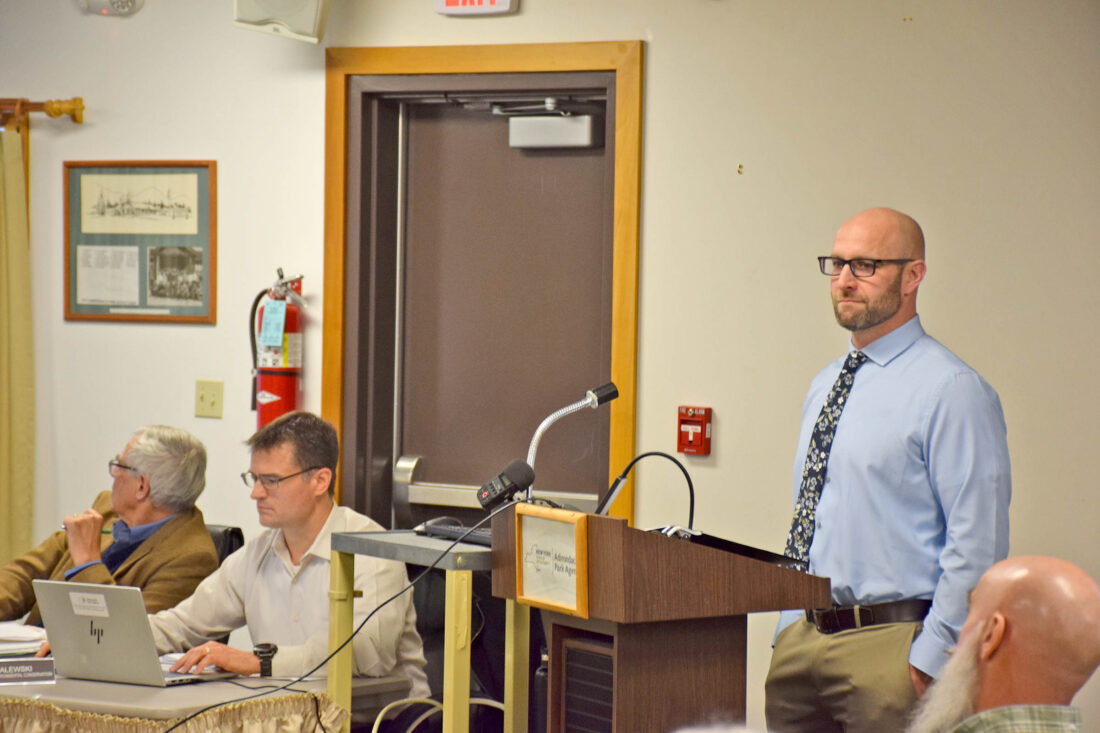
Adirondack Park Agency Deputy Director for Regulatory Programs John Burth presents at the agency’s headquarters in Ray Brook on Thursday on why APA staff recommended the board vote to send the proposed howitzer testing range in the town of Lewis to an adjudicatory hearing. (Enterprise photo — Chris Gaige)
The proposal calls for the assembly to be fired up to 30 times per year on weekdays, between 10 a.m. and 4 p.m. The proposal prescribes a maximum of two shots per day, over no more than three consecutive days at a time. The proposal does not place any seasonal restrictions on the testing. The testing is proposed for a period of five years.
The projectiles are proposed to be stopped by an 8-foot by 8-foot by 40-foot-long metal shipping container, or similar structure, filled with sand and other material. The catching system would sit 675 feet from the cannon. No explosive warheads are proposed to be fired.
The Lewis town government will be notified of the testing schedule seven days in advance, according to the proposal. It adds that all landowners within a 2-mile radius of the testing site would be notified by mail seven days in advance.
The property for the proposed testing range’s tax map number is 38.1-1-31.000. Its bounds are located 3.2 miles from the center of the hamlet of Lewis, 2.1 miles from the Jay Mountain Wilderness, 4.7 miles from the Hurricane Mountain Wilderness and about 350 feet from a discontinuous parcel of state land that’s part of the Taylor Pond Wild Forest. There are 44 residences located within a two-mile radius of the property.
Hopmeier is represented by attorney Matthew Norfolk of Norfolk Beier PLLC. The project was first proposed in 2021, though APA staff sent six notices of application incompletion for various reasons during that time before it was considered complete by agency staff on Sept. 26.
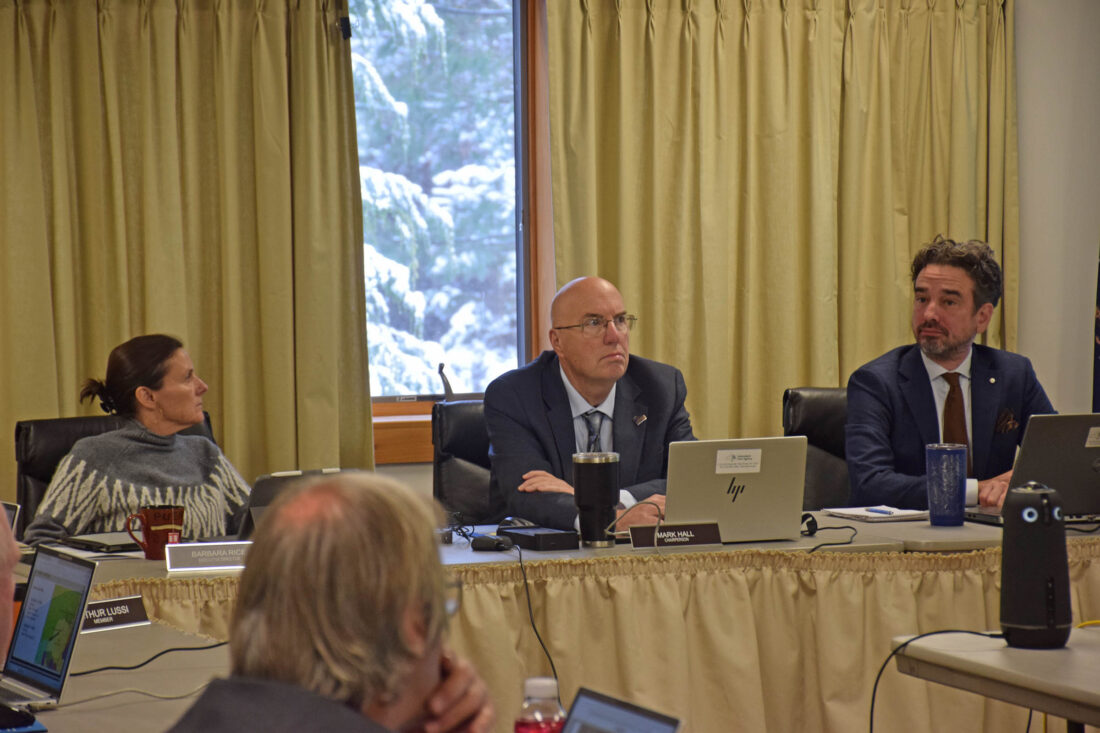
Adirondack Park Agency top officials listen to a staff presentation on the proposed Howitzer testing range in the town of Lewis at an agency meeting on Thursday in Ray Brook. From left are Executive Director Barbara Rice, Board Chair Mark Hall and General Counsel Damion K. L. Stodola. On Friday, the APA board voted to send the proposal to an adjudicatory hearing. (Enterprise photo — Chris Gaige)
“Numerous items were requested in those (notices of incomplete permit applications),” Burth said. “(These) included site plans, questions about alternative locations for the proposal, revisions to the sound study proposal, there were questions regarding noise assessment discrepancies, about efforts to mitigate potential noise impacts, design of the fire range, third-party verification regarding noise level of the howitzer and information on clarifying … (lubricants) that would be used as part of the testing process.”
The proposed project site is on a 197-acre parcel of private land classified for rural use. The land is owned by Pulsifier Logging, and the gravel pad would sit on an already cleared area. The projectiles would be fired in a west-to-east direction from the cannon to the soft catch basin, in the direction of Big Church Mountain.
An adjudicatory hearing, also known as a public hearing, gives the project’s applicant, APA staff, landowners and local governments within 500 feet of the proposed project site, any state agency and other parties to the hearing an opportunity to present evidence and to argue contested issues before an an impartial hearing officer, according to a statement from APA Public Information Director Keith McKeever.
The hearing is open to the public and any exhibits, testimony and written submissions from parties to the hearing will be made publicly available, including to members of the public who are not actively, or formally, involved in the hearing, McKeever added.
It must begin within 90 days of the project being deemed complete, per the APA Act. Since Hopmeier’s project was considered complete on Sept. 26, the latest the hearing could begin is Dec. 25, though given the Christmas holiday, it would presumably occur before then. The APA announced on Friday that it would begin the process of scheduling the adjudicatory hearing.
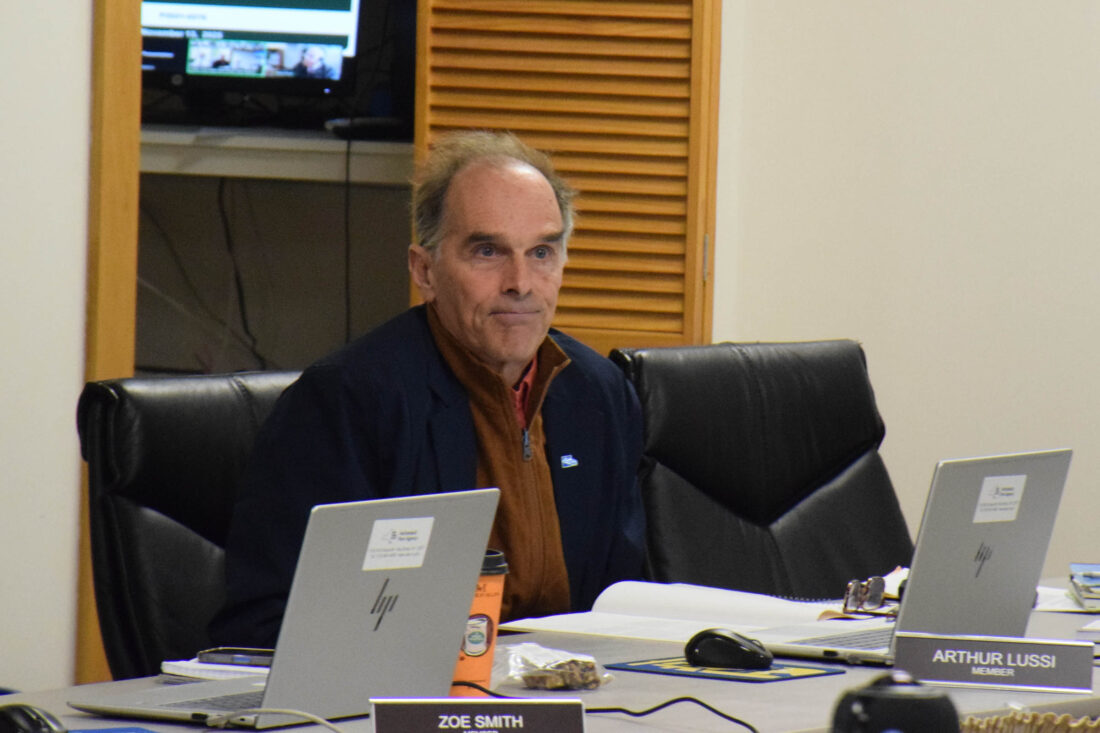
Adirondack Park Agency Board Member Art Lussi, of Essex County, looks on at the agency’s meeting at its Ray Brook headquarters on Thursday. Lussi thanked the public for submitting insightful comments on the proposed Howitzer testing range in the town of Lewis. On Friday, the APA board voted to send the proposal to an adjudicatory hearing. (Enterprise photo — Chris Gaige)
The hearing is overseen by an appointed administrative law judge, whose job is to facilitate a fair and impartial hearing, make it as run as efficiently as possible and maintain order throughout.
The administrative law judge’s final review of the hearing is presented to the APA board for its members to take into account before rendering a decision. The APA board makes a final decision, and adjudicatory hearings are the only way the APA board can deny or substantially modify a permit that is considered complete.
–
Staff presentation
–
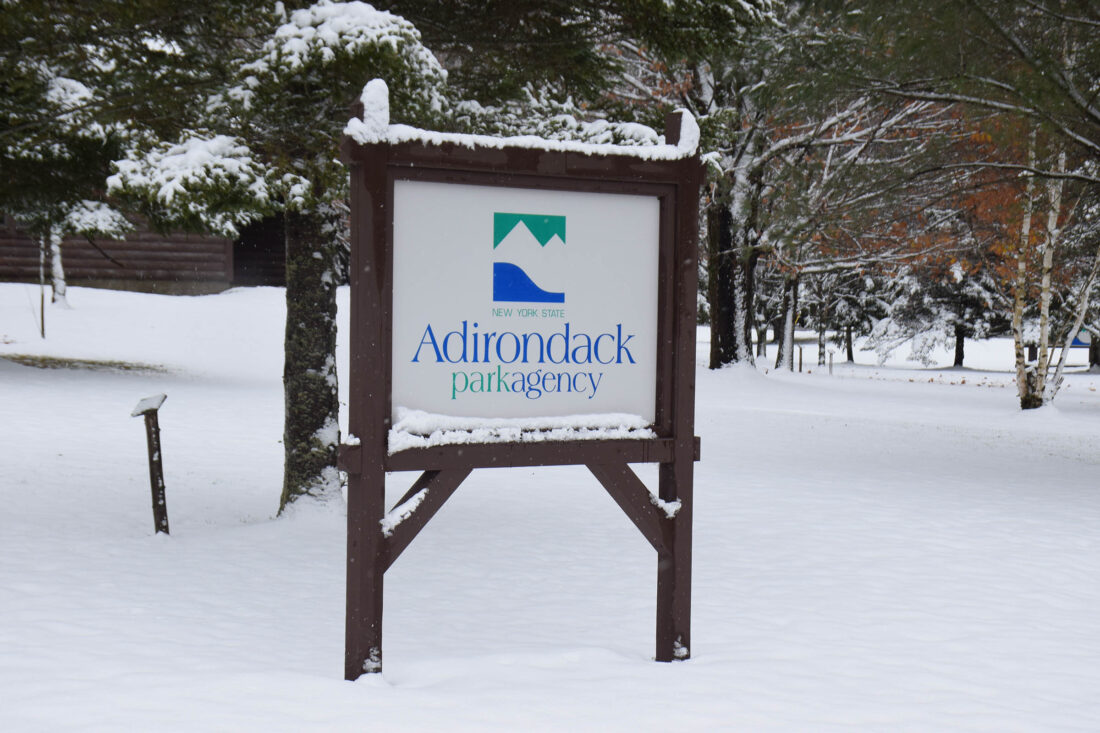
The Adirondack Park Agency sign is seen in front of its Ray Brook headquarters on Thursday. On Friday, the APA board voted to send the proposal to an adjudicatory hearing. (Enterprise photo — Chris Gaige)
On Thursday, the APA board heard from Burth. In an approximately one-hour-long presentation, he provided background on the project and laid out the various reasons why APA staff felt it should be sent to an adjudicatory hearing.
These, in short, included the project’s size and complexity, public interest, significant issues for approval, potential for major modifications or conditions, assistance from a hearing and the extent of public involvement by other means.
The slides for Burth’s presentation are available at tinyurl.com/yck4pdcr. A full recording of Burth’s presentation was not yet available as of press time Friday evening, though the APA is expected to eventually post that at tinyurl.com/57wbycu4.
Diving into potential noise impacts, Burth noted that the APA received a noise study from the applicant. It used computer modeling for the site-specific terrain derived from a 2006 Norwegian military study on the artillery, calibrated with the industry-standard 180 decibels (dB) at the barrel, or 163.2 A-weighted decibels (dB(A)) — the latter of which is based on a modified calculation to reflect a more accurate sense of how the human ear perceives sound, downplaying ultra high and low frequencies, which are not picked up as readily by most people.
Given the required permitting, on-site verification of this data was not possible in advance. The study was completed by Bowman Consulting, a licensed professional engineer on behalf of the applicant.
“Staff, in conclusion, do not feel that we can determine at this time that these models’ assumptions accurately reflect Adirondack terrain, atmosphere and background sound conditions, and whether the Norwegian study is a reliable analog,” Burth said.
The study included five “monitoring locations” to show what sound levels surrounding locations of significance would be expected to experience during the testing. These include the closest residential area, other nearby residential areas around Pulsifer Road, U.S. Route 9 and adjacent commercial activities in the area and two locations on nearby state wild lands, one about 4,000 feet away from the proposed firing pad — where the noise would be generated from and at its loudest — and another 554 feet away.
There were two scenarios modeled at each location: one with a noise mitigation berm installed at the range — which Hopmeier’s proposal includes — and one without. When the berm is included in the modeling, the study found the noise levels from the blast to be 102 dB(A) at the closest area of wild forest to the firing pad, 100 dB(A) at the monitoring location on state wildland 554 feet away from the blast site, 79 dB(A) at the monitoring location on state wildland approximately 4,000 feet away from the blast site, 73 dB(A) at the U.S. Route 9 monitoring location, 71 dB(A) at the Pulsifier Road monitoring station and and 67 dB(A) at the closest nearby residential area.
A state Department of Environmental Conservation chart Burth referenced in his presentation lists 100 dB(A) as the equivalent to someone shouting six inches away, or from a jet taking off from 2,000 feet away.
Burth noted that the sudden nature of the sound from an artillery blast — lasting less than 10 milliseconds per firing — calls for special consideration from the DEC.
“DEC guidance does explicitly flag that certain noise, especially sharp and startling noise can be extremely annoying and should be paid special attention,” he said.
Burth then pivoted to the effects on wildlife. He noted that the project did not require a biological survey to be deemed complete, given that the APA typically only requires these when a project has potential for “direct physical disturbance of habitat,” such as a land clearing — and that’s not the case here.
However, APA staff feel the potential noise impacts on wildlife warrant a biological study. Burth listed numerous adverse health impacts that wildlife have been documented to suffer at noise levels above 125 dB, especially when it’s sudden. These include hearing damage, stress physiology, reproductive failure and ecosystem change.
While these effects are known, Burth said the APA doesn’t have enough information at this time to determine what those impacts would be at this site, and that more project-specific data and mitigation evaluation are needed, which could be obtained through an adjudicatory hearing, before a finding can be made under the APA Act.
Burth then discussed potential pollution impacts, stating that the APA feels it does not have enough information currently to evaluate these. He cited Hopmeier’s comments in a 2022 Adirondack Explorer article stating that hexavalent chromium, a class of lubricants used to coat gun barrels, is dangerous and that engineers are experimenting with more “environmentally friendly” coatings, which he said in the article that he would be testing, though this was not directly quoted to him.
Burth said this was contradicted by Hopmeier’s response to two separate incomplete permit notices. One of which, the APA states Hopmeier wrote, “… there are no solvents, lubricants, coatings or other products that are applied to the inside or outside of the howitzer barrel nor used in the testing procedure.” This was in response to sixth and final incomplete permit notice, and was received on Sept. 11, 2025, according to the APA.
Given the apparent discrepancies on whether or not potentially polluting lubricants would be used, Burth said the current record is insufficient, and more information is needed to reach a finding, another reason APA staff recommended the adjudicatory hearing.
With lingering uncertainties on both noise and physical pollution, Burth said there wasn’t enough information at the moment for the APA to assess compatibility with the “rural” land use area it’s classified as. Burth then discussed the public comments, noting that the project has received significant public interest.
There were more than 1,400 written comments submitted — all but 19 of which are in opposition — according to the APA, which added that 97% of those were received between Oct. 1 and Oct. 30, the official comment period after the project application was deemed complete in September. Fifteen of the 44 residences that would be within two miles of the range submitted comments.
Many cited noise pollution and the adverse impacts on human and wildlife health, safety concerns, compatibility with surrounding residential, commercial and recreational land uses and pollution to or soil and water contamination. Those can be viewed at tinyurl.com/bdemcybu.
Hopmeier submitted a letter, dated Nov. 6, responding to the public comments. He wrote that many of them were from people who either live far away from the project or would not be impacted by it.
“Many of the comments provided no thoughtful input, revealed no critical information, were unrelated to reality, were based on demonstrably false information or were from submissions designed to provide quantitative, but not qualitative, input,” Hopmeier wrote.
His full letter can be viewed at tinyurl.com/58s2zrxe.
As far as other review groups go, Burth noted that the DEC does not need to review this, the Town of Lewis does not have land use controls here and the state Office of Parks, Recreation and Historic Preservation does not need to further review, finding there was no adverse impact on historic resources.
Since there aren’t any other government approvals or public hearings required to permit the project that the APA is aware of, Burth noted that an adjudicatory hearing may be the only forum for public consideration and review of these unique issues — another reason why staff recommended it.
–
Board members react
–
In addition to their unanimous Friday vote supporting the move, none of the APA board members expressed any disagreement to the recommendation in their Thursday questioning, which immediately followed Burth’s presentation.
APA board Member Art Lussi thanked the public for all of the comments on Thursday.
“We, as a board, sincerely appreciate when the public weighs in,” he said. “This is a great example where I really appreciate when people take a tremendous amount of time to write informed letters in support and against the proposal.”
Lussi added that with the volume and degree of conflicting points of view on the proposal, it was, in his opinion, “the perfect time” for the APA to hold an adjudicatory hearing.
After Friday’s vote, Adirondack Park Local Government Review Board Executive Director Gerald “Jerry” Delaney said he did not have any “complaints” with the agency’s handling of the howitzer range case thus far, but wanted to see more clarity on what land-use rights exist for private property owners in the park.
Delaney doesn’t have a vote on the APA board, but has a seat at the table as the local government review board’s director. He often provides advice to APA board members on what issues are pressing to local governments, and what perspective they might come at them from.
“I’d really like to see a better understanding around what is private land and what is acceptable,” Delaney said.
Shortly thereafter, APA General Counsel Damion K. L. Stodola interrupted Delaney, and advised that he withhold any comments on the project until the adjudicatory hearing gets underway. Stodola extended this advice to all APA board members, cautioning them to not have any ex parte communications about the upcoming hearing.
During the public comment on Friday after the vote, John Thompson sought to commend the APA board for its decision to hold an adjudicatory hearing. Stodola, however, cut him off once Thompson’s verbal intent became apparent. Stodola explained that while the APA appreciates public input, it was inappropriate at this time for anyone from the public to comment to the APA board about the project. This is to prevent any partiality or the appearance thereof.
Environmental conservation advocacy groups Adirondack Council and Protect the Adirondacks! both released statements after the meeting lauding the APA for voting to hold an adjudicatory hearing.
“APA staff has vast experience and expertise in a wide range of land use issues, that is not in question,” Adirondack Council Executive Director Raul J. Aguirre said. “But weapons testing, and the various impacts on wildlife, wildlands and human communities associated with it, are atypical of permit applications within the Adirondack Park. The Council appreciates that the APA board saw fit to request expert testimony before making a decision on this very challenging and unique project.”
The Adirondack Council added that the APA must fully examine potential impacts on public lands, nearby homes, local businesses, wildlife and popular outdoor recreation such as hunting, hiking and mountain biking.
“A weapons firing range has no place in the Adirondack Park,” said Claudia Braymer, Executive Director of Protect! “The Agency Board needs to hold an adjudicatory hearing so that this proposed project can be denied on the basis of its significant adverse impacts on the natural and human communities of the Adirondacks.”
Protect! added that it took issue with the applicant’s assertion that the howitzer testing range is essential for national security. Protect! added that while the APA board did not add this as an issue, the organization will seek to pursue this during the hearing.
Norfolk declined to comment immediately following Thursday’s APA staff presentation.
–
What happens next?
–
The administrative law judge’s first step is to hold a pre-hearing conference to establish parties, issues and a hearing schedule.
Participation at the pre-hearing conference is limited to APA staff, the project sponsor and those who are seeking to be parties in the hearing. The overall process could also include another public information session. This is held at the APA’s discretionand is separate from the adjudicatory hearing. The public information sessions is geared toward people who want to provide written or oral comments on the project, or learn more about it, can do so while not formally participating in the adjudicatory hearing.
At the public information session, the project sponsor generally presents first, followed by an opportunity for the public to comment. Comments offered at this session will be considered as public comment on the proposed project by the APA board.
Throughout the hearing, the administrative law judge will have power to administer oaths or affirmations; set and adjourn hearing dates and schedule for testimony and argument; rule on all motions and requests until the close of the hearing; issue, quash or modify subpoenas for the appearance of persons or the production of documents; rule on admitting or excluding evidence offered for the record; and limiting the number of witnesses and cross-examination.
Though the administrative law judge has broad authority to control and maintain the efficiency of the hearing under APA’s hearing process rules, the judge’s rulings may be appealed to the APA board at the end of the hearing by either party. The APA board may also decide to review a judge’s ruling during the hearing if the failure to do so could “unduly disadvantage” one of the parties, according to the APA’s guide to adjudicatory hearings.
The APA board’s ruling can be further appealed to state court.
It marks the first time since 2011 that the APA will hold an adjudicatory hearing. The project at that time was the proposed Adirondack Club and Resort around the Big Tupper Ski Area in Tupper Lake, which sought permitting for 719 subdivision units, among other project facets.
Though the APA ultimately approved the project, development never occurred, as the backers accrued insurmountable debts. The resort has largely sat defunct since, and was purchased at a Franklin County foreclosure auction on Nov. 7, 2024, by business partners, friends and seasonal Tupper Lake residents Josh Parnes and Martin Schapira. The two have not yet announced any plans for reopening the ski area or the surrounding land since their acquisition.

